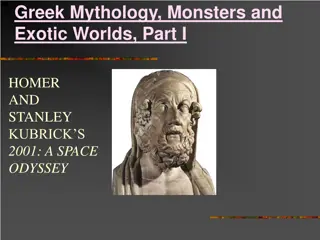The Evolution of Mythology: Unveiling the Origins of Ancient Legends
Delve into the intriguing development of myth and legend within history through the analysis of early historical documents related to the Battle of Badon Hill by four distinct authors - Gildas the Wise, The Venerable Bede, Nennius, and Geoffrey of Monmouth. Explore their differing perspectives and agendas, shedding light on the evolution of tales through time.
Download Presentation

Please find below an Image/Link to download the presentation.
The content on the website is provided AS IS for your information and personal use only. It may not be sold, licensed, or shared on other websites without obtaining consent from the author. Download presentation by click this link. If you encounter any issues during the download, it is possible that the publisher has removed the file from their server.
E N D
Presentation Transcript
CREATING MYTHS HOW DOES MYTHOLOGY DEVELOP? Dr Jon Mackley School of The Arts University of Northampton
OUTLINE OF EXERCISE This exercise considers how myth and legend develops in a sort of documentary version of Chinese Whispers . The documents provided in the resource pack (PDF file) discussed in this exercise are the earliest historical documents concerning the Battle of Badon Hill. They have been translated from the Latin. The four sources provided in the in the resource pack (PDF file) present (presumably) accounts of the same event, but the authors have different agendas. The beginning of the exercise gives a brief overview placing the writers in context. Students will then be asked to work in groups to discuss the similarities and differences between the four sources provided in the resource pack (PDF file).
THE AUTHORS OF THE FOUR SOURCES 1. Gildas the Wise c. 500 570 AD 2. The Venerable Bede c. 672/673 d. 26 May 735 3. Nennius (9THCentury) 4. Geoffrey of Monmouth c. 1100 1155
1. Gildas the Wise (b. c.500 d. c. 570) There are two writings that describe his life: one dates from the 9thcentury, the other from the 12th century According to these, he founded monasteries in Britain and Ireland before the Augustinian mission to bring Christianity to Britain in 595 Wrote On the Conquest and Ruin of Britain in Latin While The Conquest and Ruin of Britain contains details of Britain s History, the tone is that of an extended sermon, particularly condemning the acts of five clergymen The translation provided in the resource pack (PDF file) refers to Bath Hill . Other translators name it as Badon Hill . So, when writing about the Battle of Badon Hill, Gildas claims that it occurred in the year of his birth. Image from http://en.wikipedia.org/wiki/File:Statue_St- Gildas_0708_NB1.jpg, CC-BY
2. The Venerable Bede b. c. 672/673 d. 26 May 735 English monk St Peter s Monastery in Wearmouth in North eastern England (modern Jarrow). The only Native of Britain to be given the title Doctor of the Church Wrote The Ecclesiastical History of Britain around 731 Purpose was to give a history of the CHURCH in Britain, rather that the people. In other works, Bede appears to be celebrating the suppression of Pagan cultures by Christianity. Image from http://en.wikipedia.org/wiki/File:Athelstan.jpg, Public Domain
3. Nennius Little is known about Nennius. He is believed to have been a 9th century Welsh monk. The History of the Britons, written in Latin around 830, is attributed to Nennius but it is unknown whether this was one man or a collection of people. The attribution to Nennius is considered to be a later addition to the manuscript. Nennius was writing for a secular, rather than an ecclesiastical audience.
4. Geoffrey of Monmouth (c. 1100 1155) Describes himself as Galfridus Monemutensis. He was a teacher and witness to various documents in Oxford. Wrote History of the Kings of Britain in Latin around 1138. Geoffrey claims that he was simply translating an ancient book in the British language (perhaps Welsh or Breton) that was given to him by Walter, Archdeacon of Oxford. Geoffrey s purpose is to present a clear narrative history from the earliest settlers of Britain until the death of the last British king Cadwallader (689 AD) and perhaps to assert the authority of the Norman Kings. Geoffrey was made Bishop of St Asaph in North Wales, but never took office because of Owain Gwynedd s protests against central Norman rule. Image from http://en.wikipedia.org/wiki/File:Geoffrey_monm outh.jpg, Public Domain
KEY DATES 495/500 Approximate date for the Battle of Badon Hill 500 570 Life of Gildas 540 Gildas, On the Conquest and Ruin of Britain c. 570 Plague weakens Briton forces and leaves island susceptible to Saxon invasion 595 Augustine s mission bringing Christianity to Britain 672/673 735 Life of Bede 731 Bede s Ecclesiastical History of Britain 793 Viking attack on Lindisfarne, 830 Nennius writes the History of the Britains 1066 Norman Conquest 1100 1154 Life of Geoffrey of Monmouth 1135 Stephen de Blois takes English throne c. 1138 Geoffrey s History of the Kings of Britain
THE EXERCISE Each group will receive a resource pack (PDF file) containing four documents. Each of the documents describes the same event. Discuss in groups the similarities and differences between the pieces. Considerforexample, thedate, thelocation, thelengthofthe piece, which characters and races are represented, what sources they might have used and any other details you may consider relevant. Which text do you find the most convincing and why? Take into consideration the date and context of when the texts were written and the motivation of the authors. Note that the texts may begin or end midway through a sentence. (There is one page each for Gildas, Bede and Nennius and four pages for Geoffrey)
FINDINGS Gildas (Text 1) Factual account. Dates battle against foes that arrived 44 years before (c. 495AD). He describes the siege as obsessionis Badonici montis (Giles translates this as BathHill , most other accounts call it Badon Hill). Gildas says battle was the year of his birth (does he mean the battle or the arrival?) Significantly names Ambrosius Aurelianus in the previous passage (Gildas does not name many other people). However, it s not clear whether Ambrosius is leading the battleDoes not name enemies, but says the war was because of civiltroubles and was the slaughter of our cruel foes . Bede (Text 2) Does not specifically name the enemies (the Angles in the title has been added by a later editor). Enemies had been in the land for 44 years. The British people implor[e] Divine help , and gives a brief outline of the leader of the Britons named as Ambrosius Aurelianus, particularly the storm which he survived but which killed his parents who were of the royal race . Outlines the slaughter of the enemies at the siege of Badon Hill.
Nennius (Text 3) Does not date the battles. Arthur is named as the hero. Placed in the context of Arthur s twelve campaigns, Badon Hill is the mostsevere . Arthur is not named as king, instead in the Latin text he is called dux bellorum which Giles translates as Commander . Arthur defeated the enemy (here they are Saxons) in all campaigns. Describes how 940 people fell by his[Arthur s] hand alone . In an earlier battle, it is said that Arthur has the image of the Virgin Mary on his shield Geoffrey (Text 4) Battle is situated as a siege of the town of Bath; description is more complete. Tone is different: it reads like a story rather than a history. Geoffrey employs rhetoric speaking of the treachery of the pagans and discusses how he attacked the Saxons . Many details concerning the battle. Arthur is named as King. His shield and weapons are all named. He has an image of Mary on his shield, Priwen. Very much a Christian soldier who rushed forward into the thickest of the enemy s ranks [and] with his Caliburn alone, [he] killed four hundred and seventy men . Geoffrey does name someone who fell on the Britons side who was killed.
OBSERVATIONS Gildas was interested in writing a sermon, rather than a history. He gives no details about the battle, but that was never his intention. He is writing just a short time after the event and the details would have been subject to local, oral legend. If Gildas was contemporary with Arthur, it might not have been necessary to mention him. Bede drew on Gildas as a source, but adds details that he (Bede) would have read from other sources to make it more comprehensive. However, Bede is writing an Ecclesiastical, rather than secular history. Nennius probably used Gildas as a source, but takes the legend of Ambrosius and attributes it to Arthur. Geoffrey used Nennius, but, like Nennius, he changes names and attributes deeds to other characters to simplify the narrative. For example, the name Priwen is taken from the Welsh tradition but refers to Arthur s ship, rather than his shield. (His shield in Kulhwch and Olwen is called Wynebgwrthucher and his sword is called Caledfwlch, which Geoffrey changes to Caliburn). However, Arthur is named here as King . Geoffrey has a political agenda to give the English nation a hero.
FINAL THOUGHTS Nennius sHistory of the Britons is the first time that Arthur is named in a text. He s not a King, just a commander ; he isn t named king until Geoffrey. There is another text, a seventh century Welsh poem called Y Gododdin which describes how one of the characters glutted the ravens on the ramparts, even though he was not Arthur (that is, he defeated many mercenaries, despite the fact that he wasn t Arthur). It is argued that this reference might be a later interpolation. The fact that Nennius attributes twelve (successful) battles to Arthur suggests the importance of his mythological status and that it had developed in the century between the time that Bede and Nennius were writing. It is plausible that Nennius took a number of local legends and attributed them to Arthur, including that of Ambrosius.
SELECT BIBLIOGRAPHY Aurell, Martin. Geoffrey of Monmouth sHistory of the Kings of Britain and the Twelfth-Century Renaissance in The Haskins Society Journal. Ed. Stephen Morillo. Vol. 18. Woodbridge, the Boydell Press, 2006: 1 18. Barron, W.R.J. (ed.). The Arthur of the English. Cardiff: University of Wales Press, 2001. Guen e, Bernard. States and Rulers in Later Medieval Europe. Oxford: Blackwell Publishing, 1988. Jankulak, Karen. Geoffrey of Monmouth. Cardiff: University of Wales Press, 2010. Morris, John. The Age of Arthur: A History of the British Isles from 350 to 650. London: Weidenfield and Nicholson, 1973. Tatlock, J.S.P. The Legendary History of Britain: Geoffrey of Monmouth sHistoria Regum Britanniae and its Early Vernacular Versions. Berkeley and Los Angeles: University of California Press, 1950. Wright, Neil. Geoffrey of Monmouth and Gildas . Arthurian Literature 2(1982): 1 40.
ACKNOWLEDGEMENT Permission has been granted by In Parentheses Publications to use the following sources: Gildas: http://yorku.ca/inpar/gildas_giles.pdf Nennius: http://www.yorku.ca/inpar/nennius_giles.pdf Geoffrey: http://www.yorku.ca/inpar/geoffrey_thompson.pdf The following source is in Public Domain : Bede's Ecclesiastical History of England, by The Venerable Bede, http://www.documentacatholicaomnia.eu/03d/0627- 0735,_Beda_Venerabilis,_Ecclesiastical_History_Of_England,_EN.pdf

 undefined
undefined
























